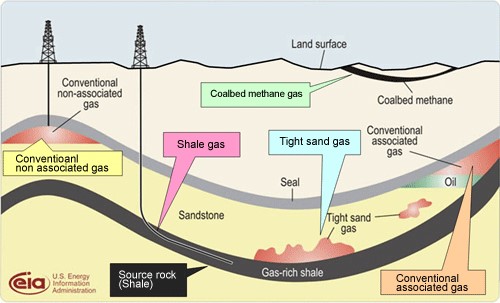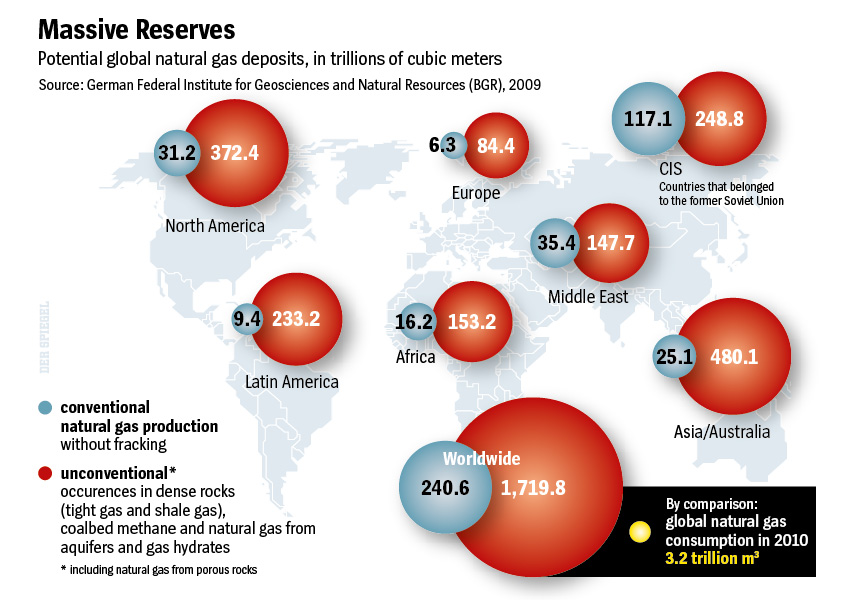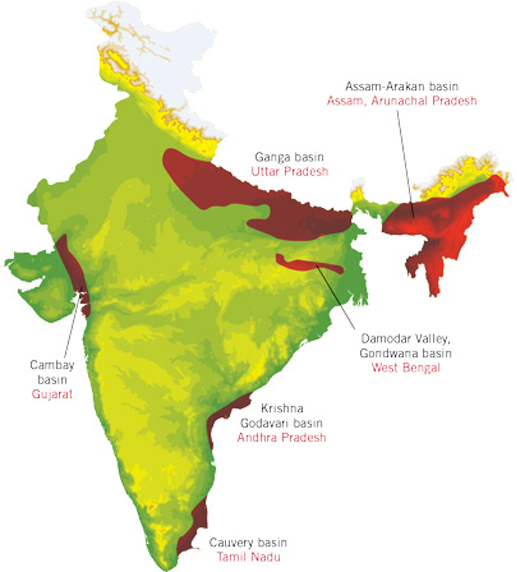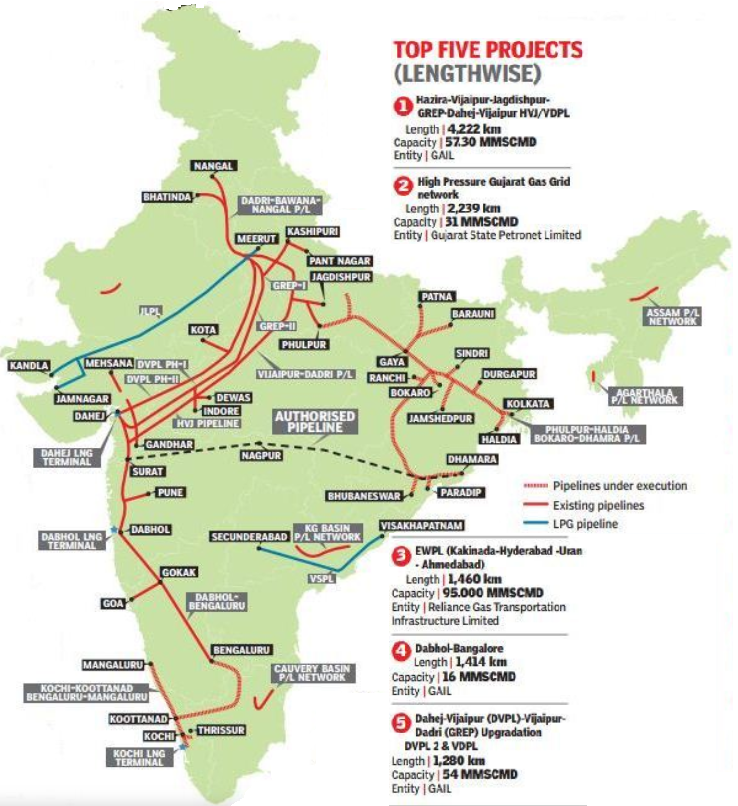Gas based economy
2022 OCT 13
Mains >
Science and Technology > Energy > Unconventional gas Energy sources

IN NEWS:
- The committee on suggesting fair price of natural gas to the end-consumer, chaired by former Planning Commission member Kirit Parikh, has sought a month’s time from the Ministry of Petroleum & Natural Gas (MoPNG) to submit its recommendations on domestic gas prices.
WHAT IS NATURAL GAS?
- Natural gas, also called fossil gas, is a naturally occurring hydrocarbon gas mixture consisting primarily of methane, with small percentages of carbon dioxide, nitrogen and hydrogen sulfide.
- It is formed when layers of decomposing plant and animal matter are exposed to intense heat and pressure under the surface of the Earth over millions of years.
- Natural gas is found in deep underground rock formations or associated with other hydrocarbon reservoirs in coal beds and as methane hydrates. Petroleum is another resource found close to and with natural gas.
- It is used as a source of energy for heating, cooking, electricity generation, as a fuel for vehicles and as a chemical feedstock in the manufacture of plastics and several organic chemicals.
IMPORTANCE OF NATURAL GAS:
- Environment friendly:
- Gas offers an affordable solution to the dichotomy between development and environment. Replacing conventional fuels with gas would help India meet its target of cutting down greenhouse gas emission under the Paris climate deal.
- Accessibility:
- Gas can be efficiently transported over long distances through pipelines. This can help in the development of national gas grids and ensure energy access to areas like North-east India, Ladakh and LWE affected areas.
- Affordable & sustainable energy:
- Ensuring basic energy services to all is a major goal under the SDGs. Gas is relatively cheaper and can fulfill India clean energy demands, diversify its energy basket and reduce import bill.
- Sustain Industrial growth:
- India will emerge as the third largest energy consumer behind the US and China by 2030, according to IEA’s India Energy Outlook. Despite this growth, India suffers from chronic energy poverty. Hence, sustained supply of gas is expected to be a key driver in the growth of fertilizer, power and steel sectors in the coming years.
- Sustain social growth:
- Indians use biomass such as dung, agricultural waste and firewood for cooking. These fuels cause indoor pollution and increase the burden of disease of the womenfolk. Energy from gas can help counter these issues.
- Less vulnerable to geopolitical tensions:
- Unlike Petroleum, natural gas reserves are more diverse. Hence, they are more insulated from geopolitical tensions like oil blockades, economic sanctions and wars.

- Aligns with India’s foreign policy:
- Natural gas trade can help India increase its maneuverability in global geopolitics. For eg: In the past few years, India imported LNG from Russia to address Moscow’s concern over India’s growing proximity with the US in matters of energy and defence hardware purchase.
GOVERNMENT EFFORTS:
In 2018, the government had announced the plan to raise the share of natural gas in the country’s primary energy mix to 15 per cent by 2030 from the present level of 6 per cent. To attain this, India has taken the following measures:
- Policy support:
- Hydrocarbon Exploration and Licensing Policy (HELP) policy:
- HELP provides for a uniform licensing system that will cover all hydrocarbons such as oil, gas, and coal bed methane.
- It offers marketing and pricing freedom and adopts the revenue sharing model. Here, the government will receive a share of the gross revenue from the sale of oil, and gas, and will not be concerned with the cost incurred.
- Natural Gas Marketing Reforms:
- The objective of the policy is to prescribe standard procedure to discover market price of gas, through a transparent and competitive process, and allow marketing freedom.
- India has also announced a plan to create an independent gas transportation company, providing open access to gas carriers, and reducing the monopoly of traditional gas actors including GAIL.
- Increase domestic production:
- India has 26 sedimentary basins and several blocks have been offered for exploration and production under the Open Acreage Licensing Policy (OLAP). About 83.3% of natural gas production is by ONGC and OIL and the remaining by Private/Joint venture companies.

-
- National Gas Hydrate Program (NGHP) was launched by Ministry of Petroleum & Natural Gas as a consortium of National E&P companies - ONGC, GAIL and OIL and National Research Institutes for research in methane gas hydrates beneath India’s coastal waters.
- Diversified imports:
- Till 2016, India sourced LNG only from Qatar but that has since diversified its sources to the US, Australia and Russia.
- India has significantly increased its LNG imports. For instance, India had agreed with Russia to import LNG worth an estimated USD 25 billion over 20 years.
- More storage and distribution infrastructure:
- “One Nation One Gas Grid”:
- Petroleum and Natural Gas Regulatory Board (PNGRB) has authorized approximately 33,500 km natural gas pipeline network across the country with the aim to create a national gas grid and increase the availability of natural gas across the country.

-
- India is also investing in creating LNG import facilities:
- Eg: Petronet is looking to set up a floating LNG import terminal at Gopalpur in Odisha in the next 3 years.
- Natural gas exchange:
- India’s first gas exchange- the Indian Gas Exchange (IGX)- was launched in June, 2020. The exchange is expected to facilitate transparent price discovery in natural gas.
- Stronger distribution network:
- Development of City Gas Distribution (CGD) networks to provide Piped Natural Gas (PNG) to households, industrial uses and Compressed Natural Gas (CNG) for transportation uses.
- Projects such as Urja Ganga project and Indradhanush Gas Grid Ltd
- Pradhan Mantri Ujjwala Yojana for providing clean cooking gas connections to the underserved in the country.
CHALLENGES:
- Import dependency:
- India, the third largest energy consumer and four biggest LNG importer in the world, is dependent on imports to meet 45 per cent of its gas needs.
- Dual pricing regime:
- India has multiple prices for domestic and imported gas. Also, India revises its domestically produced gas price on a half yearly basis based on the conditions in international markets. This remains unattractive for new investments and makes accurate demand forecasts difficult.
- Monopoly by GAIL:
- GAIL owns early 70% of the gas transmission network in the country. This has discouraged private sector to be involved in the development of supply and distribution systems.
- Competition from other sources:
- The competition of low-priced coal and renewables, especially in the power sector, remains a major impediment.
- Under-utilisation of current assets:
- The Parliament Standing Committee on Energy’s report has identified 14.3 GW of stranded gas-based plants with an investment of over Rs. 650 billion, most of it lent by banks. Also, capacity utilisation of LNG terminals such as in the case of Ennore and Kochi is another concern.
- Low utilization increases cost to customers, erodes profitability and creates non-performing assets.
- Skyrocketing global natural gas prices:
- The Russia-Ukraine crisis has resulted in sudden increase in gas prices in the international markets. This has made imports costly.
- Russia was the largest exporter of natural gas in 2021. But its invasion of Ukraine changed the equations, and plunged Europe into an energy crisis.
WAY FORWARD:
- Investment in Pipelines:
- For India to increase the share of gas in its primary energy mix, new pipelines would be required.
- Pipeline access needs to be provided to private buyers and sellers of gas on a non-discretionary basis.
- Public private partnership (PPP):
- Government financing through private partnership and other innovative ideas for funding pipeline projects is essential to clear the path for raising funds.
- Revise pricing:
- The NITI Aayog has lined up a proposal to give complete marketing and pricing freedom to natural gas produced in the country.
- Include under GST:
- Natural gas is outside the purview of GST and is subject to state VAT. Hence its price suffers large regional variability. Cascading taxation disincentivises consumption and must be brought under GST.
- Give preference over other sources:
- To achieve its 15% gas share target, India needs more than tripling the current consumption level. This pathway can be achieved through the promotion of natural gas at the expense of other hydrocarbons, coal in particular.
PRACTICE QUESTION:
Q. The transition towards a gas-based economy is instrumental in India’s ambition of transforming its energy system towards more efficiency and sustainability. Discuss?



